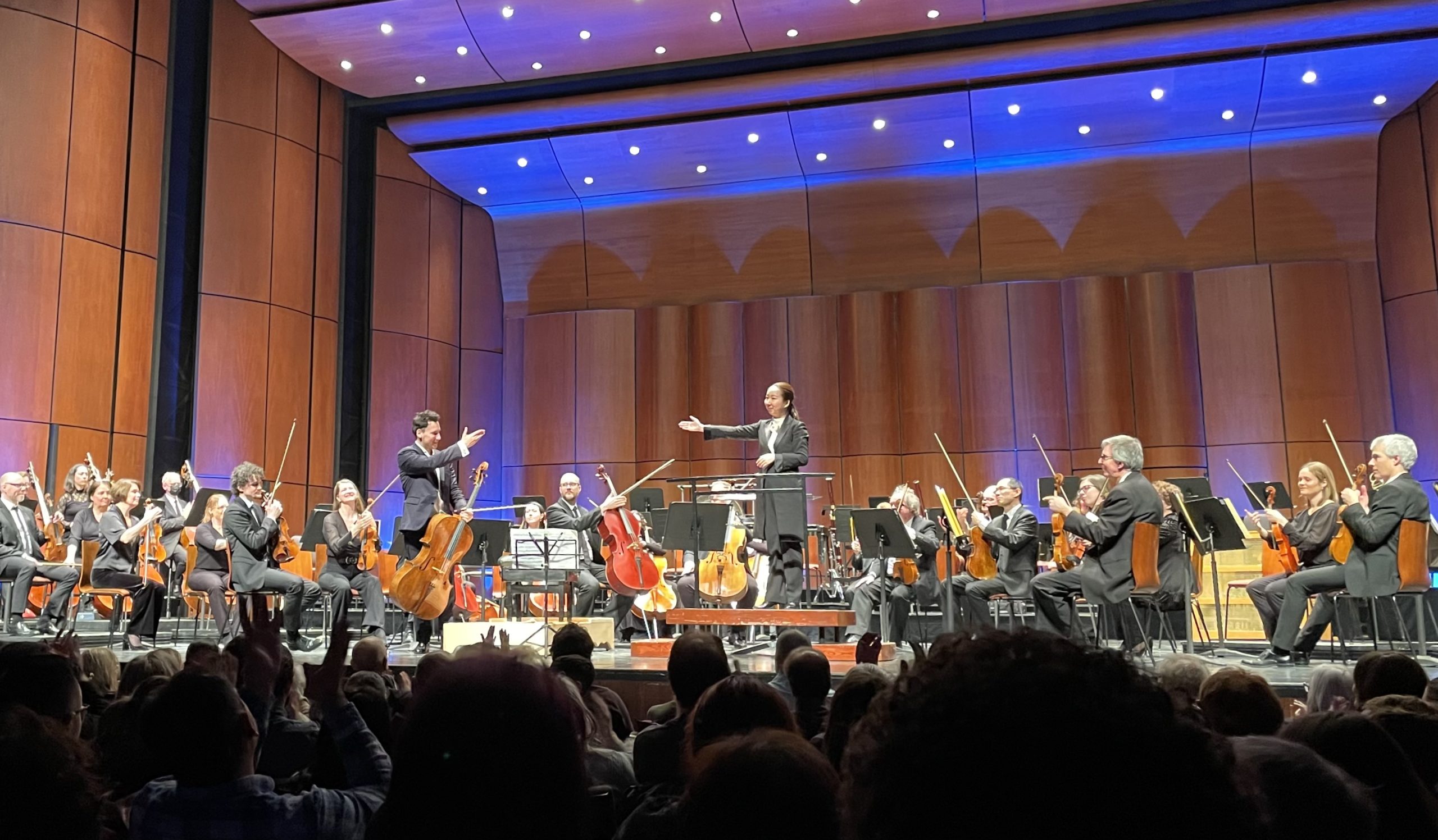Navigating Expo Habitat to create your ideal home Lise Lafond lise@qctonline.com Expo Habitat, held at Expo Cité from Feb. 22 to 25, is a dedicated exhibition focusing on housing and…
Tag Archives: March 6 2024
Provincewide forum seeks perspectives of local English-speaking youth
Provincewide forum seeks perspectives of local English-speaking youth Ruby Pratka, Local Journalism Initiative reporter editor@qctonline.com Provincewide civic participation organization Youth 4 Youth Québec (Y4Y) is seeking young people aged 16-30…
BOOK REVIEW: Mike James Ross launches Intention: The Surprising Psychology of High Performers
BOOK REVIEW: Mike James Ross launches Intention: The Surprising Psychology of High Performers Shirley Nadeau shirley@qctonline.com The 50 or so people in College Hall at the Morrin Centre on Feb….

COMMUNITY CHRISTMAS HAMPER CAMPAIGN: Pound for a Claus drums up funds for food
COMMUNITY CHRISTMAS HAMPER CAMPAIGN: Pound for a Claus drums up funds for food…
QCNA Newsmatters: Local newspapers produce game-changing coverage
QCNA Newsmatters: Local newspapers produce game-changing coverage
Content provided by the Quebec Community Newspapers Association
“We have boots on the ground, and often our stories get picked up by larger media.”
-Nikki Mantell, publisher, the Low Down To Hull and Back News
Community newspapers do a lot with a little. The result is game-changing coverage that not only informs the immediate regions they serve, but reflects the issues that contribute to the pub- lic conversations on a provincial and national scale.
While large media outlets were debating the possible ramifications of Bill 21, Quebec’s so-called secularism law that prohibits civil servants and other public-sector workers from wearing religious clothing or jewelry, the editor of The Low Down to Hull and Back News was interviewing Grade 3 teacher, Fatemeh Anvari, in the little town of Chelsea, Que., in the Outaouais region. She had just been fired for wearing a hijab.
“That’s one of the stories that wouldn’t get picked up if we wouldn’t do them,” said The Low Down’s publisher Nikki Mantell.
The story, broken by a newsroom with a staff of three, was picked up by the Ottawa Citizen, The Globe and Mail, the National Post and international outlets, including Newsweek and The Guardian.
It put a human face on Quebec’s often-virulent secularism debate — and, as Mantell put it, “changed the discourse.”
Mantell continued: “Before The Low Down published Ms. Fatemeh’s story, support for Bill 21 was hovering around 64 per cent. Following the story, which every major news outlet in Canada picked up, support for the bill dropped to 55 per cent.”
In another corner of the province, in the Vaudreuil- Soulanges region west of Montreal, when Bill 96 threatened to strip small bilingual towns of their dual-language status, the mayor of one of those tiny communities appeared set to let the deadline for the municipal council to affirm its will to keep the status expire. The local English-language paper in the region, The 1019 Report, questioned the mayor. On repeated occasions that spanned months, the mayor refused to commit whether council would vote on the needed resolution.
In response to the coverage, residents in the tiny town of 120 grew concerned. Two reporters with The 1019 Report started working the phones and going door to door. By the time they were done, the paper reported on the results of an exhaustive survey: a clear majority of residents of the island community of Île Cadieux wanted the town to keep its official bilingual status.
“Most of the residents credit[ed] the paper” when the resolution was finally renewed, said The 1019 Report editor Brenda O’Farrell, adding that large media outlets would never have bothered to do the legwork.
“We spread ourselves thin. We work really hard. And we’re good at stretching a buck,” said Mantell. “We put our hearts and souls into this.”
This is the type of journalism the Local Journalism Initiative helps produce. The federal fund- ing program provides resources to hire journalists who produce civic content – coverage of health, education, rights, public policy and other essential issues.
It also ensures that members of Quebec’s English-speaking community continue to be in- formed. As Lily Ryan, publisher of The Aylmer Bulletin and the West Quebec Post, points out, as the province’s language of business and politics is French, English-language papers offer the minority community the opportunity to stay in touch with what is going on in their communities and government decisions.
QCNA NEWSMATTERS: Local news by the numbers
QCNA NEWSMATTERS: Local news by the numbers
Content provided by the Quebec Community Newspapers Association
10,815 Local Journalism Initiative articles on civic issues produced at QCNA publications between April 2019 and February 2024. (SOURCE: QCNA)
518 local news operations that closed between 2008 and Feb. 1, 2024 (SOURCE: LOCAL NEWS RESEARCH PROJECT)
547 job cuts announced by Quebec television network TVA in November 2023. (SOURCE: TVA)
800 job cuts announced by CBC in December 2023. (SOURCE: CBC)
1269 media jobs eliminated in Canada during first year of the COVID pandemic. (SOURCE: LOCAL NEWS RESEARCH PROJECT)
4800 job cuts announced by Bell Media in February 2024. (SOURCE: BELL MEDIA)
QCNA NEWSMATTERS: Community newspapers emerging as last journalistic soldiers standing
QCNA NEWSMATTERS: Community newspapers emerging as last journalistic soldiers standing
Content provided by the Quebec Community Newspapers Association
“Community newspapers aren’t just filling the gap, they’re the whole fabric.”
-Brenda O’Farrell, journalist and president of the Quebec Community Newspapers Association
Last month, Bell Media announced its largest workforce restructuring in 30 years, laying off 4,800 workers.
In December, CBC/Radio-Canada announced plans to cut 800 jobs.
One month earlier, Quebec television network TVA cut 547 jobs.
Earlier in 2023, Postmedia, one of the largest media companies in Canada with a daily newspaper in almost every major city in the country, announced it was cutting 10 per cent of its staff, just the latest in a long string of downsizing moves that has spanned more than a decade. The cuts planned for Quebec went much deeper.
Almost every month, evidence of the continuing shift in the media landscape can be seen. And the result is fewer and fewer journalists reporting the stories that keep Canadians informed.
But in many communities a singular journalistic soldier remains standing: The community newspaper. These small, often privately-owned outlets are the last providers of reliable, professional local news.
“Community newspapers aren’t just filling the gap, they’re the whole fabric,” said veteran journalist and president of the Quebec Community Newspaper Association Brenda O’Farrell.
That is why support for community newspapers is so important, O’Farrell says. As the media landscape continues to shift, the role these news outlets play is not only crucial, but gaining importance.
And they need to be supported by initiatives like the federal government’s Local Journalism Initiative, O’Farrell explains, referring to the funding program that helps qualified outlets hire reporters in communities across the country. But readers in these communities, have to do their part, too, she added, by subscribing to papers that offer that option, especially in Quebec where the minority-language community needs to maintain access to information in English.
Without programs like LJI and reader support, many community papers would struggle to survive.
Since 2012, journalist Marie-Ève Martel has tracked community news outlet closures across Quebec.
“For the moment, I’ve counted more than 80,” she reported late last year, after the abrupt shuttering of the Montreal daily Métro and its offshoots in several Montreal suburbs and Quebec City.
Each closure represents not only jobs lost, but “a hole in our social cement,” as Martel describes it.
Local media “makes us more informed, more aware and more likely to vote,” she said.
“CBC and the Ottawa Citizen aren’t going to cover a byelection in Chelsea,” said Nikki Mantell, the publisher of The Low Down to Hull and Back News, which covers the small towns in the Gatineau hills. “We have boots on the ground, and often our stories get picked up by larger media.”
“Local papers are where you hear about the most important things — health care, schools, get- ting your roads paved, the environ- ment,” said Sharon McCully, publisher of The Record in Sherbrooke and the Brome County News, two papers that cover about 30 municipalities for the English-speaking community in the Eastern Townships. “These are stories that impact people directly.”
 Musicians/actors from Philippe Robert’s play take a bow: Olivier Maranda (percussion), Anne-Marie Levasseur (actor and horn), Valérie Descheneaux (Éloi the oboe) and Pierre- Alexandre Maranda (double bass). (Photo by Danielle Burns)
Musicians/actors from Philippe Robert’s play take a bow: Olivier Maranda (percussion), Anne-Marie Levasseur (actor and horn), Valérie Descheneaux (Éloi the oboe) and Pierre- Alexandre Maranda (double bass). (Photo by Danielle Burns) REVIEW: Musical play starts March Break on a good note
REVIEW: Musical play starts March Break on a good note Danielle Burns danielle@qctonline.com Do, Re, Mi, Fa, So, …? A musical about an oboe who loses his La, and uses…
 The collectif9, a nine-member string ensemble from Montreal, present their immersive concert of Waves and Shadows at the Palais Montcalm on Feb. 16. (Photo by Shirley Nadeau)
The collectif9, a nine-member string ensemble from Montreal, present their immersive concert of Waves and Shadows at the Palais Montcalm on Feb. 16. (Photo by Shirley Nadeau) REVIEW: collectif9 takes Club musical audience on aquatic voyage
REVIEW: collectif9 takes Club musical audience on aquatic voyage Shirley Nadeau shirley@qctonline.com The audience at the Palais Montcalm was totally immersed in a concert entitled Vagues et ombres / Waves…
 French classical cellist Edgar Moreau and Japanese conductor Nodaka Okisawa congratulate each other after Moreau’s performance with the OSQ. The orchestra alone then launched into the amazing New World Symphony by Antonín Dvořák. (Photo by Shirley Nadeau)
French classical cellist Edgar Moreau and Japanese conductor Nodaka Okisawa congratulate each other after Moreau’s performance with the OSQ. The orchestra alone then launched into the amazing New World Symphony by Antonín Dvořák. (Photo by Shirley Nadeau) REVIEW: OSQ presents Dvořák’s New World Symphony
REVIEW: OSQ presents Dvořák’s New World Symphony Shirley Nadeau shirley@qctonline.com Feb. 18, was a lovely day to attend a concert by the Orchestre Symphonique de Québec at the Grand Théâtre,…
